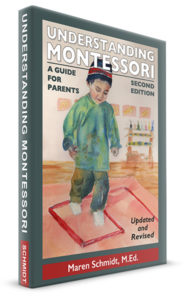From Understanding Montessori
Download Family Needs Questionnaire
Download School Visit Questionnaire
Chapter Introductions
Chapter 6: Finding A Quality Montessori School
Finding a School that Fits Your Family’s Needs
Before you think about a specific school, there are important issues that should be considered. Understanding these sometimes subtle matters will help make your school choice more thoughtful, more comfortable, and in the long run, more successful.
The first item we need to consider in finding a quality Montessori program is the needs of your child, along with the needs of your family. This chapter is to help bring to your awareness these needs. Our family needs questionnaire will help you begin focusing on finding a good school match for your family.
Montessori schools come in all shapes and sizes, from a classroom in a teacher’s home to a multi-building complex with several hundred students. As you explore different Montessori environments, you’ll find differences and similarities. The differences will be based on meeting the needs of the children in that school at that time with the resources available. The similarities should be schools trying to implement Montessori philosophy in the best way they know.
Chapter 7: Visiting A Montessori School
Setting Up the Visits
Using the information in the previous chapter locate at least three schools that you would like to visit. If there is only one Montessori school in your area, visit other schools, either private or public, and use these same checklists. It is important to know that you have made your decision based on as much information as possible.
Call each school and ask about their enrollment and visiting procedures. Most schools now have websites that give you information about the school’s visiting and enrollment policies.
Some schools may not do initial one-on-one visits and may instead offer open houses at different intervals during the year.
One-on-one visits
Call each school and arrange for a visit. Ask each school how much time you should allow for a tour. Morning visits are recommended if you want to see a preschool classroom in action. Three- and four-year-olds usually are in a morning half-day program. This means you will probably have to do the visits over at least two or three days to allow yourself adequate time.
Open house visits
Inquire about the format of the open house visit so that you can be prepared to gather information. Some open houses start with a group meeting and a tour of each classroom, allowing for time to visit with staff and administrators.
Surprise visits
Some childcare advocates recommend surprise visits to schools. That is fine if you want to get an insight of how the school runs when company isn’t expected. If you expect a tour and someone to spend an hour or more with you, make an appointment. School administrators are busy people, plus there is always the risk that, without an appointment, the children won’t be in school that day for some reason.
Checklist: Things to Ask
Remember, you are asking questions for a long-term situation, not just for your child’s immediate needs. You may want to bring these checklists with you, of course, or you may feel more comfortable filling them out afterwards in your car or at home. You might also be able to answer many of these questions from the school’s website and brochures.
Some of these questions may appear invasive. It is better to have a long-term view of the school you select for your children. It is not ideal for your children to be pulled out of a program after a few weeks or months because you weren’t aware of certain policies or procedures. It is to your advantage and the school’s best interest to invest the time in the beginning to have a good match.
The School Visit Questionnaire is available on-line and may be downloaded from my website: www.MarenSchmidt.com.
(Note: Rest of Chapter 7 steps you through the questionnaire to understand what answers to expect and why.)
